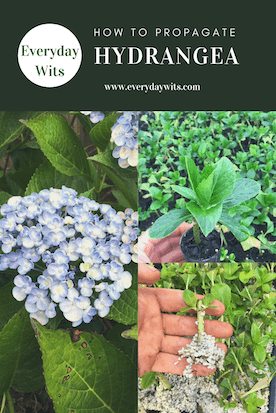
In this article we will show you exactly how we propagate hundreds of hydrangeas every year in our wholesale nursery.
We will be using softwood cuttings. The best time of year to take softwood hydrangea cuttings is as close as possible to the longest day of the year.
By taking the cuttings at at this time of year we are able to strike the roots in only 4 weeks!
All you need is:
- Secateurs
- Perlite
- Peat moss
- Pots
- Potting mix
Taking the cuttings
Like i said the best time to take softwood cuttings of hydrangea is around the longest day of the year. Hydrangeas also do well as a hardwood cutting taken during winter.
But right now for this article we are focused on softwood cuttings.
Softwood refers to the new growth, it’s green and slightly flexible. As opposed to the hardwood, which is brown and rigid.
As we are taking the cuttings near as possible to the longest day of the year the hydrangeas are usually in full flower.
Some people don’t like to take cuttings during this time but it’s easily the fastest time of year to generate roots.
First we harvest some stems. Some with flowers, some without in terms of success rates we find it makes no difference whether the stem has a flower or not.
To create the cutting first we cut just below a leaf node. A node is where the leaves emerge from the stem. This node once buried in the propagation mix will sprout roots. If there are leaves at the node simply strip them off.
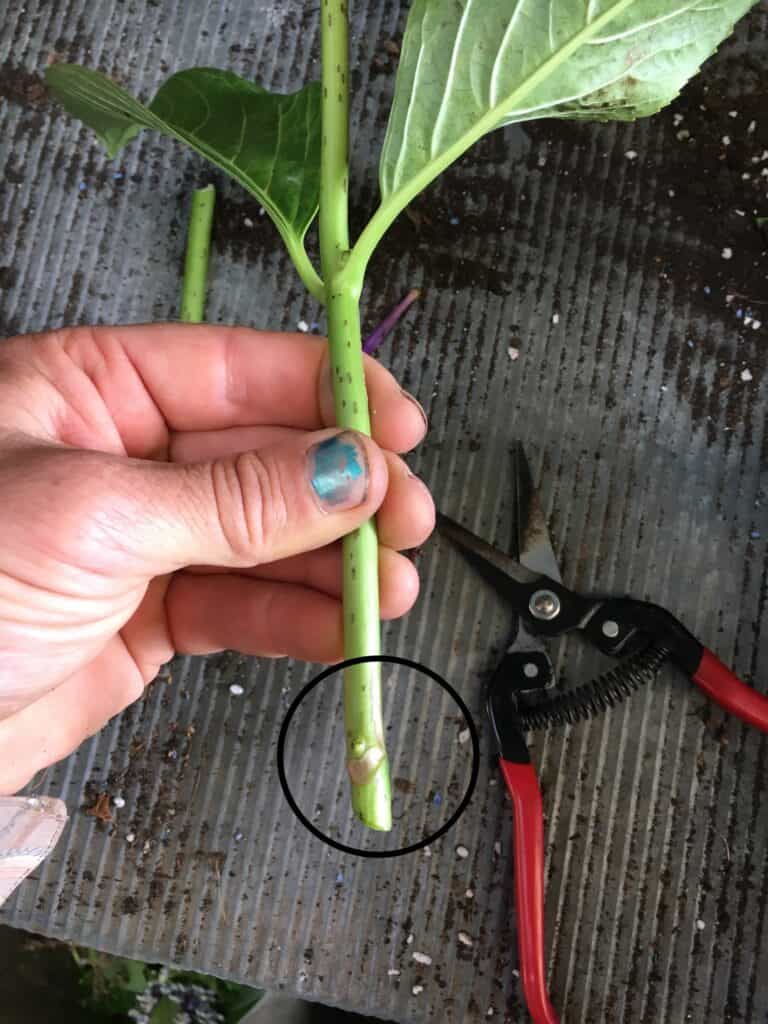
Next we cut just above the next set of leaves. This is another node of course. But this node is exposed to the air and light and will sprout steams and foliage later.
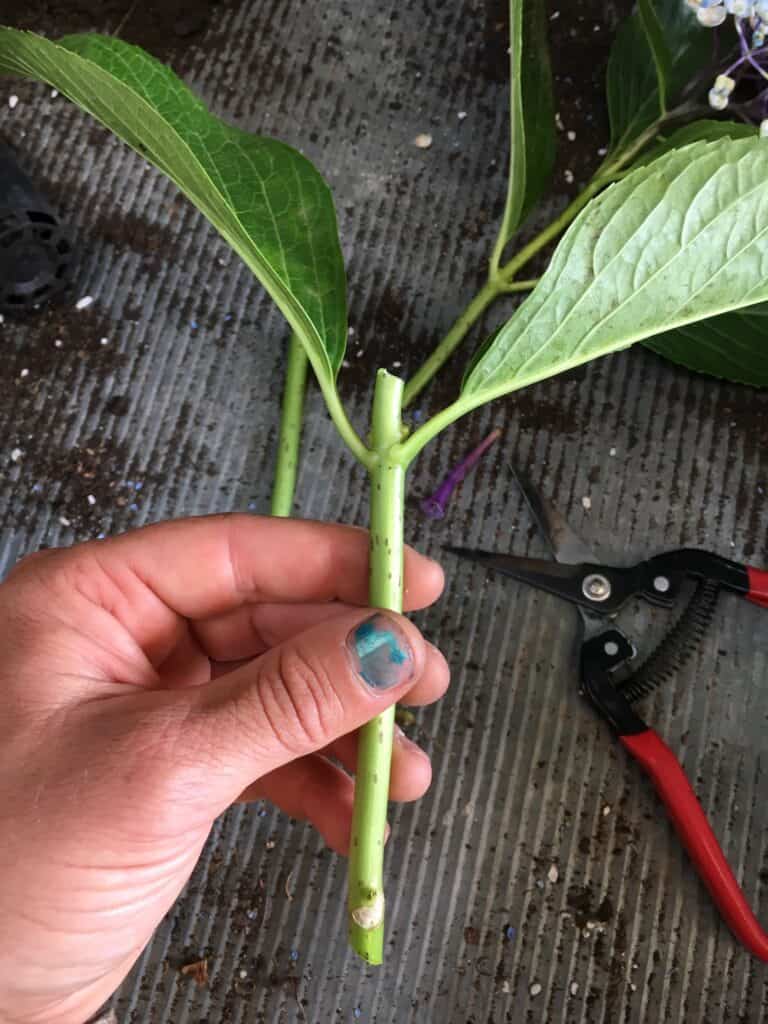
Lastly we trim the leaves to about 1/4 of their original size. Now we can plug them into our propagation mix.
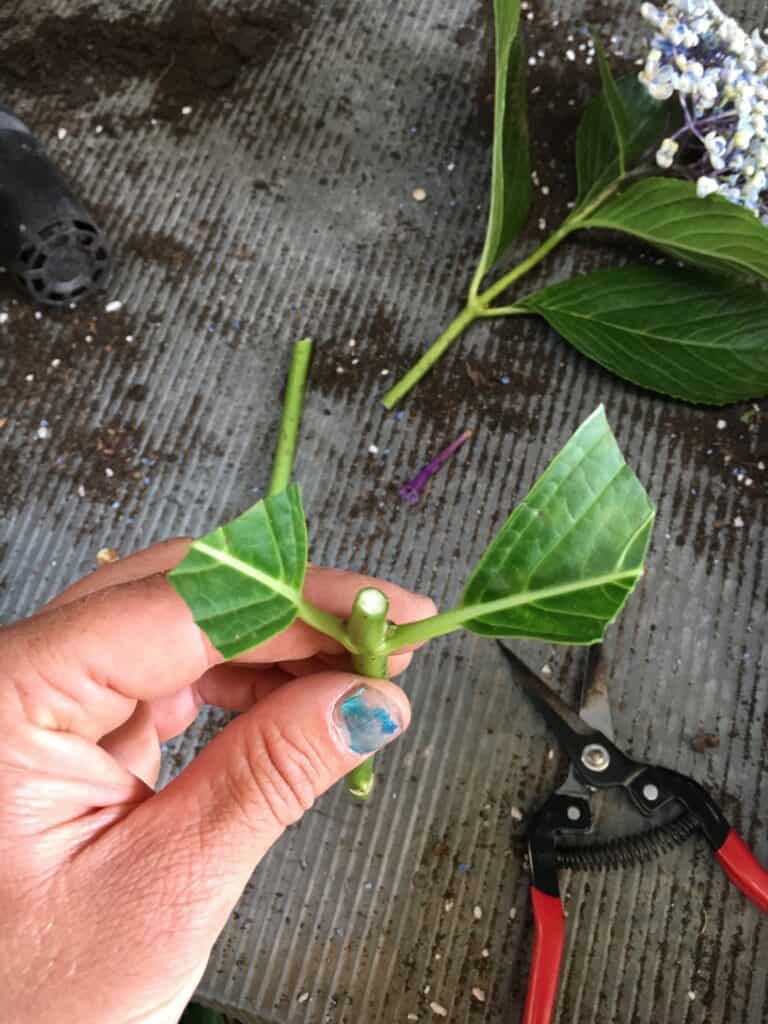
Striking roots
To strike the roots we use a mix of perlite & peat moss. Both are excellent at holding moisture. Whole the perlite allows good air circulation.
We use a mix of 90% perlite and 10% Peat moss. We use this mix on almost all the different plant cuttings we do. With over 10 years of successful propagation why change?
All we do is plug the cuttings into the mix. So long as the node without leaves is below the surface roots will strike.
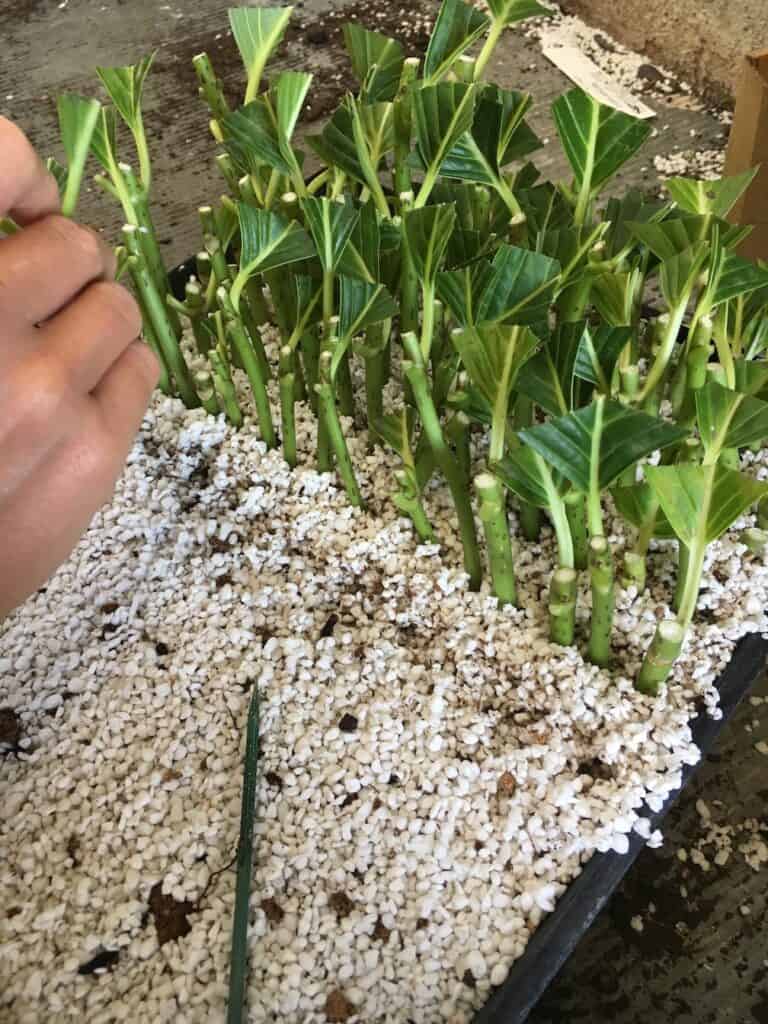
We use seedling trays, but you can use a pot or any other container provided it has good drainage.
Once the cuttings are plugged into the mix, they must be given a through drink. Water until the water flows freely through the drainage holes.
Now the cuttings need to be kept in a sheltered well lit area. We use our greenhouse. So long as it’s an area that is protected from direct sunlight and wind, you’ll be fine.
Wind and direct sunlight will quickly dry out the cuttings and you’ll be left with brown dead stems.
Speaking of drying out, don’t let the cuttings dry out. Keep the perlite and peat moss mix moist at all times!
Provided you’ve taken your cuttings near the longest day of the year you can expect roots in 4 weeks!
We expect a success rate of 90% on our hydrangea cuttings.
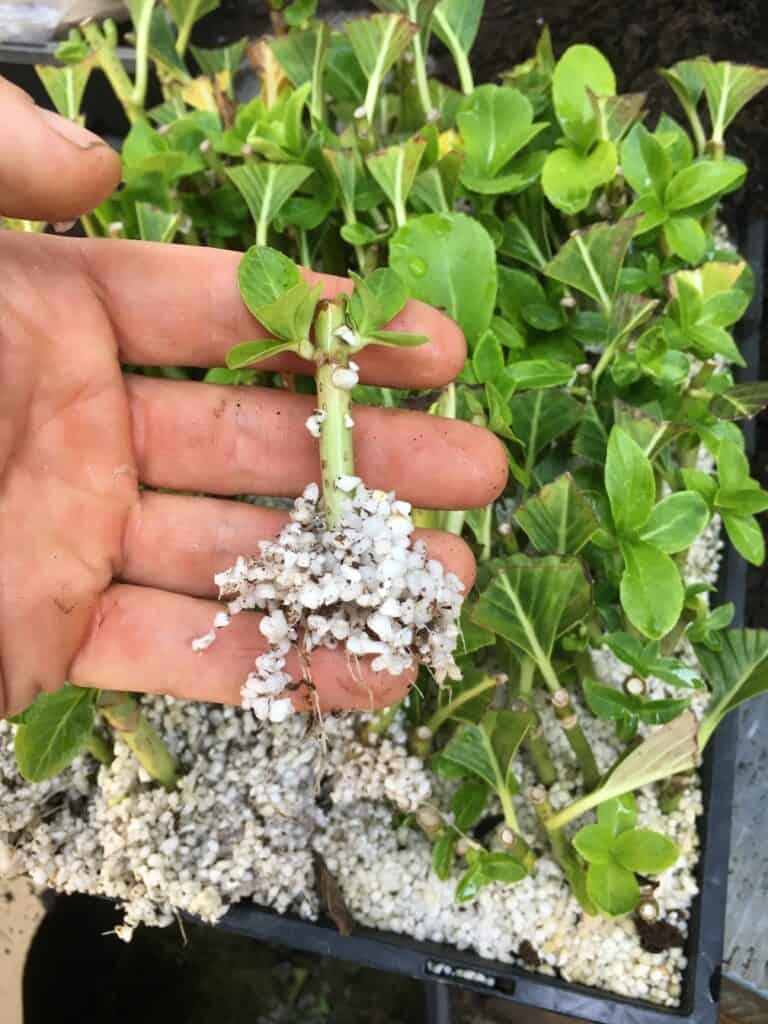
Now that the cuttings have roots, it’s time to pot them into some soil 🙂
Potting the cuttings
Our cuttings are potted into 2″ (50mm) pots. We do this to save on space in the nursery.
If you’re only propagating a handful of plants feel free to use larger pots. I recommend 6-8″(15-20cm) pots as a good size for hydrangea cuttings.
When potting the cuttings try and use a good quality potting mix. Plenty of organic material and trace elements.
Later on you might like to add some slow release fertiliser, but right now it’s unnecessary.
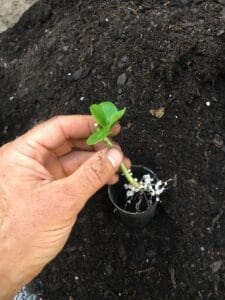
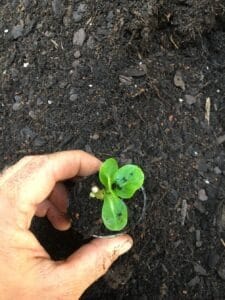
We like to water our cuttings with seasol. This is a seaweed based fertiliser, we find it helps speed up root growth and development.
Either way whether you use seasol or not really water the freshly potted plants well! Again until the water flows freely out of the drainage holes.
Now the plants need to be kept safe for approximately one more month. Once again we place ours into our greenhouse. Remember just keep them out of direct sunlight and wind.
Keep the potting mix moist at all times, but be careful not to overwater. The plants have roots now and the risk of drying out has reduced significantly. Hydrangeas can be prone to mildew and over watering can easily lead to an outbreak.
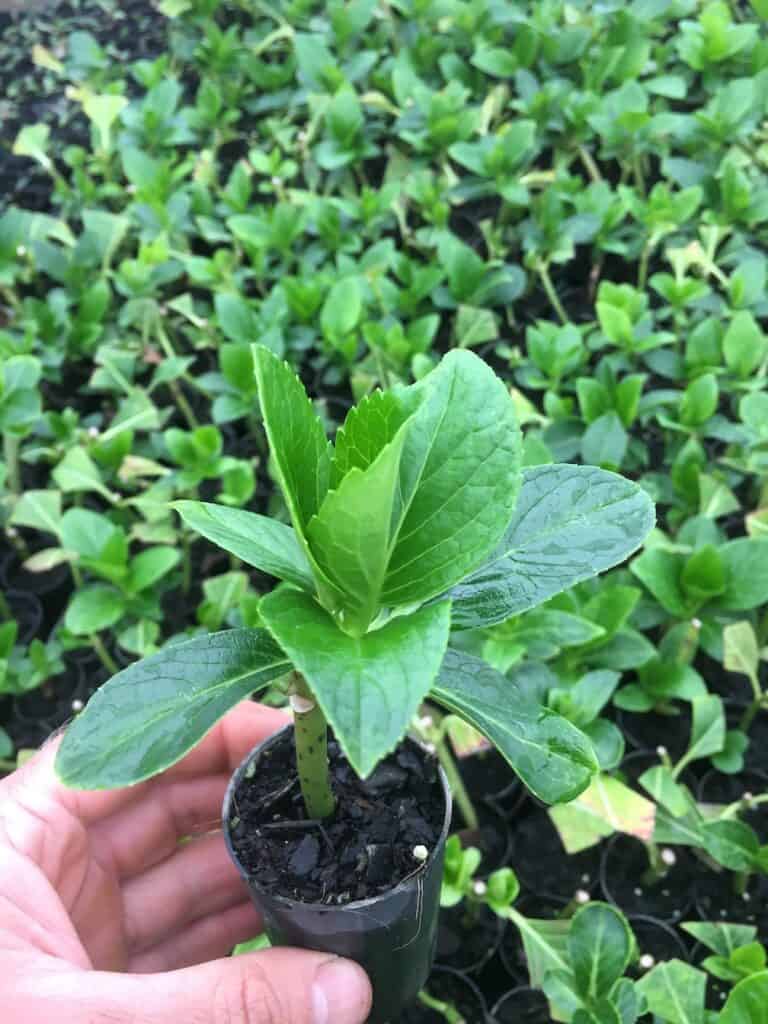
A month later the plants should be developing a nice healthy root system. We now remove them from the greenhouse. Once the roots have filled the pots they can be planted into the garden or larger pots, whichever you prefer.
Hopefully this has inspired you to go ahead and propagate your own hydrangea cuttings.
If this has been helpful remember to subscribe so you don’t miss out on any of our propagation articles.
Happy planting!
Propagation tools
To view links on the products we use when propagating be sure to click on the link.
Also you can click here to see all the other plants we propagate. I think there is now over 50 articles and growing!
Oh and below is a short video/slideshow showing the above steps.
Propagate hydrangea cuttings video
Hydrangea Information
Hydrangeas are a hardy deciduous shrub. They are grown for their large striking flowers which are produced from late spring into summer.
The most common flower colours are white, blue, pink and red. The pink and blue are actually the same plant but will change colour depending on the pH of the soil.
If your soil is alkaline your hydrangeas will turn pink. While an acidic soil will turn them blue.
Adding a soil sulphur will create a more acidic soil and therefore blue hydrangeas. Or adding garden lime will create a more alkaline soil thus turning them pink.
Hydrangeas are a great plant for cottage gardens, around ponds or semi- shaded areas.
They prefer moist well draining soil. Keep them well watered during hot dry summers as they are prone to wilting.
Cultural notes
Botanical name: Hydrangea
Common name: Hydrangea
Family: Hydrangeaceae
Native to: Mostly Asia
Flowers: Late Spring-Summer
Position: Full sun, part shade
Height: 1-2m
Width: 1-2m
